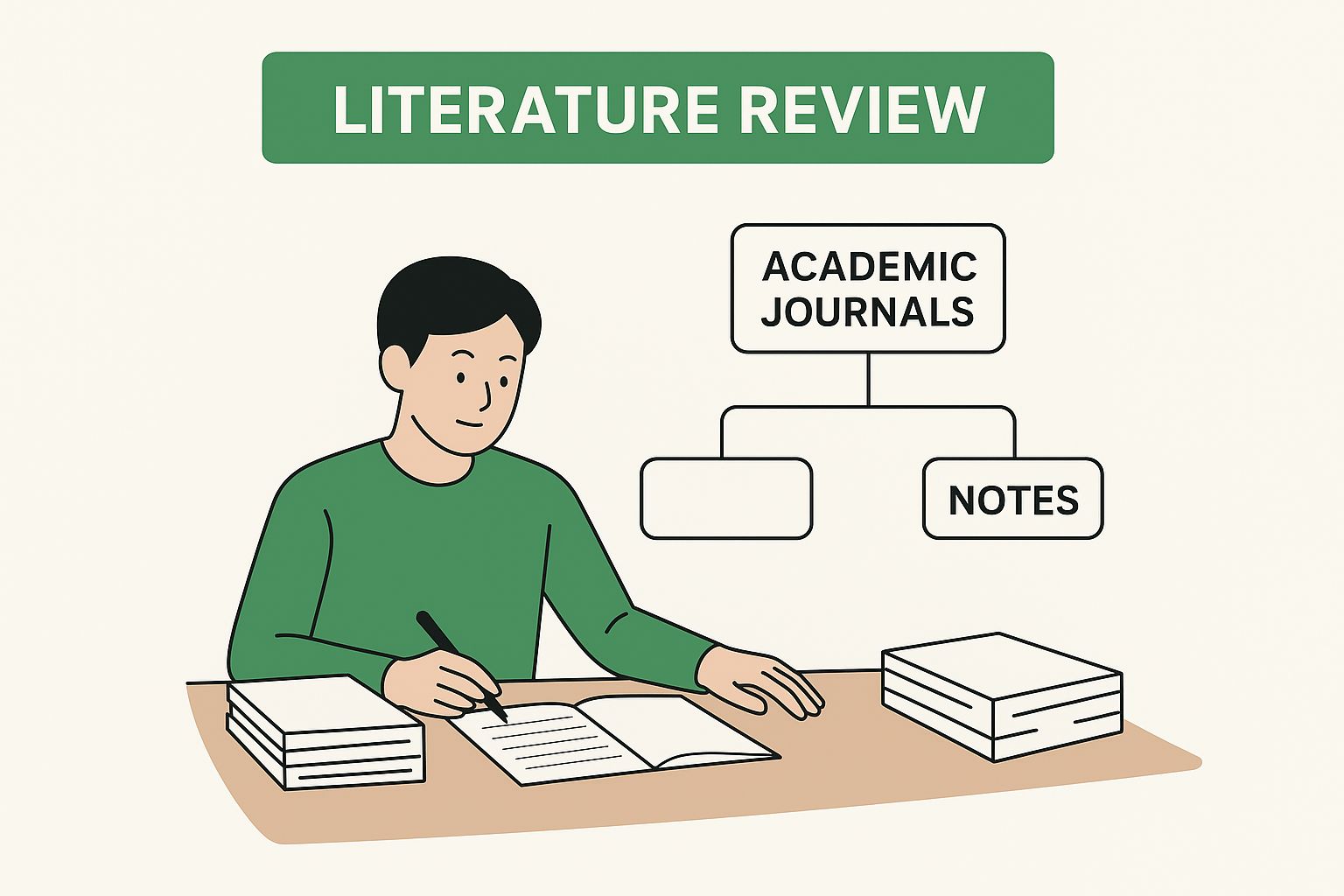
Guidelines for Writing a Research Paper: Your Complete Guide
June 12, 2025
Why Research Paper Guidelines Actually Matter (More Than You Think)
Imagine: you've spent weeks meticulously crafting a research paper, only to have it rejected because of formatting issues. It's like a chef creating a culinary masterpiece only to serve it on a paper plate. The substance is there, but the presentation undermines its impact. In the competitive academic landscape, following research paper guidelines isn't just about ticking boxes—it's about effectively showcasing your hard work.
Think of these guidelines as the common language of academia. They provide a structure that allows anyone, regardless of their background, to understand your work. A well-structured paper respects the reader's time and makes your arguments clearer, increasing the likelihood of your research being understood, valued, and cited.
Guidelines: The Secret Weapon for Academic Success
These guidelines aren't arbitrary roadblocks; they arose from a need for clearer communication. Different fields have unique conventions. A literature review in the humanities will naturally differ from one in the sciences. However, the core principles of clarity, conciseness, and accurate referencing remain universal.
The rise of standardized guidelines has been a game-changer. Reporting checklists, like the CONSORT statement for clinical trials and PRISMA for systematic reviews, are prime examples. In fact, a 2018 survey showed that 78% of researchers in high-income countries used at least one such guideline, revealing a growing understanding of standardized reporting's role in improving research quality. Find more on writing research papers at: EQUATOR Network
Let's illustrate this evolution with a table:
To demonstrate the impact of guidelines over time, consider the following:
Table: Evolution of Research Writing Standards
| Decade | Key Guidelines Introduced | Adoption Rate | Impact on Publication Quality |
|---|---|---|---|
| 1990s | CONSORT early versions | Emerging | Increased transparency in clinical trial reporting |
| 2000s | PRISMA, STROBE | Growing | Improved reporting of systematic reviews and observational studies |
| 2010s - Present | Expansion and updates of existing guidelines | Widespread | Enhanced rigor and reproducibility in research |
This table shows how the introduction and adoption of reporting guidelines have progressively improved the quality and transparency of published research over the past few decades.
Navigating the Guideline Landscape
The EQUATOR Network is an invaluable resource. It offers guidance on various reporting guidelines. The image below shows their website, a hub for evidence-based reporting.
The site provides a wealth of information, from guidelines for different study designs to publication resources and training materials. It champions transparent and accurate reporting in health research, aiming to boost the reliability and usefulness of published findings.
Improving your general writing skills also strengthens research writing. For more tips on writing effective essays—which share key principles with research papers—check out this resource: How to Write Better Essays
Ultimately, grasping and applying research paper guidelines isn't about conforming to rigid rules. It's about learning the language of academic discourse. This allows you to present your work effectively, maximizing its impact and contributing meaningfully to your field. By using these guidelines, you're not only boosting your publication chances; you're helping build a more robust and accessible body of knowledge.
Planning Your Paper Like a Master Architect
Imagine you're an architect tasked with designing a skyscraper. You wouldn't start laying the foundation without detailed blueprints, would you? The same principle applies to crafting a compelling research paper. Solid planning is essential. Think of the image below – it shows how a literature review functions much like an architect consulting building codes, providing a framework for your project.

Just as an architect studies existing structures and regulations, a literature review helps you understand the existing knowledge landscape. Your notes and research become the building blocks, forming a solid base for your own unique contribution.
Identifying Your Core Argument: The Foundation
Before putting pen to paper (or fingers to keyboard!), you need a strong central argument. This is the bedrock of your entire paper. Imagine building a house on sand – it simply won't hold. A research paper without a clearly defined argument is equally unstable. This central argument is the main point you're trying to persuade your readers to accept, backed by the evidence you present. It's the guiding principle for your entire writing process.
Building a Flexible Outline: The Framework
With your foundation in place, you need a framework to guide your construction. This is where your outline comes in. Think of it as the architectural plans for your research paper. A good outline provides structure without being overly rigid. It should chart the logical progression of your argument, section by section.
Take a look at this image of the Wikipedia page on academic writing:

The sheer volume of information highlights the need for clarity and conciseness in academic writing. A well-structured outline helps you navigate this complex landscape and communicate your ideas effectively.
Organizing Your Ideas: The Blueprints
Now for the detailed work – arranging your ideas like an architect plans the placement of every beam and wall. This involves sorting your research notes, pinpointing key supporting arguments, and strategically placing each piece of evidence within your outline. Consider this your detailed blueprint.
Before we dive further into drafting, let's look at a checklist to ensure you've covered all the crucial planning stages. This table provides a roadmap for each phase, highlighting key activities, estimated time investment, and indicators of successful planning.
Research Paper Planning Checklist: Comprehensive checklist covering all essential planning phases from topic selection to final outline.
| Planning Phase | Key Activities | Time Investment | Success Indicators |
|---|---|---|---|
| Topic Selection | Brainstorming, Literature Review, Feasibility Assessment | 1-2 weeks | Clearly defined research question, Relevant existing literature |
| Argument Formulation | Developing a thesis statement, Identifying supporting arguments | 1 week | Concise and arguable thesis statement, Logical supporting points |
| Outline Development | Structuring the paper, Sequencing arguments, Planning sections and subsections | 1 week | Coherent structure, Logical flow of ideas |
| Resource Gathering | Collecting data, Identifying sources, Evaluating evidence | 2-4 weeks | Sufficient and credible sources, Organized research materials |
| Timeline Creation | Setting deadlines for each phase, Allocating time for writing and revisions | 1 day | Realistic deadlines, Contingency plans for delays |
This checklist helps you break down the planning process into manageable steps, ensuring a smooth and efficient journey from initial concept to final draft. Remember, careful planning in these early stages sets the stage for a successful and impactful research paper.
Setting Realistic Timelines: The Construction Schedule
Just as a construction project requires a schedule, your research paper needs a timeline. Divide the writing process into smaller, achievable tasks. Set practical deadlines for each section, accounting for research, writing, revisions, and potential setbacks. This phased approach prevents overwhelm and maintains momentum.
This meticulous planning may seem like a lot upfront, but it’s the key to creating a research paper that is not only well-organized but also engaging and persuasive. Like a skilled architect, you are building a structure designed to withstand scrutiny. By following these planning strategies, you're ensuring your research not only gets noticed but also makes a lasting impact in your field.
Crafting Each Section With Surgical Precision
Every research paper section plays a vital role, just like the specialized tools a surgeon uses. Think of it this way: mastering each section elevates your work from a rough sketch to a polished masterpiece. This section explores the anatomy of a research paper, explaining not just the what but the why and how of each part, creating a compelling whole.
The Abstract: Your Paper's Elevator Pitch
Imagine you're in an elevator with a potential investor. You have mere seconds to pitch your groundbreaking idea. That's your abstract. It's the first impression, the hook that draws readers in. It should be concise, informative, and engaging, summarizing your research question, methods, findings, and implications.
Introduction: Setting the Stage
Think of your introduction as the opening scene of a play. It sets the stage, introducing the topic and its importance. It hints at the unfolding story by presenting your research question or thesis statement. A compelling introduction explains the "why" – why this research matters and what you aim to achieve.
Literature Review: Building Upon Existing Knowledge
The literature review isn't just a summary of other people's work. It's like having a conversation with the greatest minds in your field. You're analyzing their work, identifying gaps in knowledge, and positioning your research within this ongoing academic discussion.
Methodology: Showing Your Work
Transparency is key in research. The methodology section is where you show your work, explaining how you conducted your research. Think of it as a recipe – you're listing the ingredients (data collection methods) and the steps you followed (analysis). This allows others to replicate your study and verify your findings.
Results: Presenting Your Findings
The results section is where you present your findings, pure and simple. Use charts, graphs, and tables to visualize your data – think infographics. Avoid interpretation here; just present what you observed or measured.
The screenshot below from Purdue OWL illustrates a suggested research paper structure, highlighting the typical flow of information.
This screenshot emphasizes the importance of a clear, logical progression, guiding the reader through each research stage. Each section builds upon the previous, creating a cohesive and persuasive argument.
Discussion: Interpreting Your Findings
Now it's time to interpret. The discussion section is where you connect your findings back to your research question. Explain what your research adds to the field. Acknowledge any limitations and suggest future research avenues – think of it as opening new doors for exploration.
Conclusion: Bringing It All Together
The conclusion is your closing argument. Summarize your main findings and reiterate their significance. This is your final chance to leave a lasting impact on the reader.
Transitions: Ensuring a Smooth Flow
Imagine a conductor leading an orchestra. Transitions are the subtle cues that ensure a seamless flow between sections. They connect ideas, creating a cohesive narrative. These can be single words, phrases, or even entire sentences.
By understanding each section's purpose and mastering the art of transitions, you can craft a compelling and impactful research paper. It’s like composing a symphony, where each instrument plays its part in creating a harmonious and impactful whole.
Writing With Authority (Without Sounding Like a Robot)
Academic writing sometimes gets a bad rap, conjuring up dusty books and stiff, impersonal prose. But writing with authority doesn't mean you have to sound like a robot. Think of your research paper as a well-told story—you've uncovered something important, and you're sharing it with the world. The guidelines for writing a research paper simply help you tell that story effectively. Your voice should be professional, yet approachable, like the outfit you'd pick for an important conference: polished, but still reflecting your personality.
Finding Your Authentic Voice
Developing an authoritative voice is about finding the sweet spot between precision and personality. You want to convey complex ideas clearly and concisely, keeping your readers engaged without dumbing things down. Imagine explaining your research to a colleague over coffee. You'd use clear language, real-world examples, and maybe even a little humor to keep them interested. This conversational approach, adapted for academic writing, can make your paper both informative and enjoyable.
For example, instead of saying "The aforementioned data corroborates the hypothesis," try something like, "Our findings really back up our initial idea." These small changes make your writing more direct and accessible. Weaving in storytelling elements, like a short anecdote or a real-world application of your research, can also draw readers in and make your work memorable.
Avoiding Style Pitfalls
Some writing habits can actually undermine your credibility. Overusing jargon without explaining it, relying on passive voice, or being overly formal can make your paper seem detached and impersonal. It's like wearing a stiff, uncomfortable suit – it just doesn't feel right.
Mastering Consistency and Professionalism
A consistent voice throughout your paper is key. Imagine reading a novel where the narrator’s personality keeps changing—it would be jarring and confusing! Similarly, shifts in tone or style in your research paper can disrupt the flow and weaken your argument.
The screenshot below, from the University of Wisconsin-Madison's Writing Center, shows a helpful overview of the research paper planning process.

This screenshot highlights how important planning is before you even start writing. Just like an architect wouldn't start building without blueprints, a researcher should think carefully about the structure and flow of their paper before drafting. This pre-writing stage is crucial for a clear, consistent argument.
Balancing authenticity with professional standards is the ultimate goal. Your voice should be your own, but it also needs to follow the rules of academic writing. Think of it like tailoring a suit – it’s still a suit, but it fits you perfectly. For more tips on improving your writing, check out this helpful resource: Improve Your Writing Skills. By finding this balance, you can write with authority, engage your readers, and make sure your research has a real impact.
The Guidelines That Actually Boost Your Acceptance Chances

This image shows the homepage of Global Journals Inc., an open-access publishing platform. Notice how organized and well-presented the different research areas are. This reflects the importance of clear structure, which is exactly what research paper guidelines are all about.
Let's explore why these guidelines are so important. It's more than just making your paper look good. Imagine building a house. You could just start piling up bricks and wood, but a blueprint (your guidelines) helps ensure a strong and stable structure. The same principle applies to academic publishing.
Why Guidelines Are Your Secret Weapon
Journal editors are busy people. They want to quickly assess your paper's quality and relevance. Guidelines offer a familiar framework, making that assessment much easier. A clear abstract, for instance, lets an editor grasp your main argument right away. A well-defined methodology builds confidence in your research process.
Following guidelines also shows respect for the publication and the academic community. It demonstrates that you’ve taken the time to understand and follow the rules, making your work easier to review and understand. This attention to detail can significantly improve your chances of getting published. Studies show that manuscripts following guidelines are up to 40% less likely to be immediately rejected. For example, a 2021 analysis found that STEM papers with standard structures had a 33% acceptance rate, compared to only 18% for those lacking such structure. Learn more at: Global Journals Inc. Research Paper Writing
Choosing the Right Guidelines
Just like different buildings require different blueprints, different journals and fields have specific guidelines. You wouldn't use the same blueprint for a skyscraper and a tiny house, right? The same logic applies to journals. A medical journal will have different requirements than a history journal.
Finding the right guidelines is essential. Carefully review your target journal’s "Instructions for Authors." This section details everything from word count and formatting to referencing styles and ethical considerations. Need help with your writing? Check out our guide on professional writing tips.
Guidelines as Strategic Advantages
Many researchers see guidelines as restrictions, but they're actually valuable tools. They help you organize your thoughts, present your findings clearly, and meet your audience's expectations. This not only increases your chances of acceptance but also improves the readability and impact of your work. By understanding and using these guidelines, you transform them from obstacles into opportunities.
Revision Strategies That Transform Good Into Great
Imagine sculpting a masterpiece. You wouldn't chisel once and expect perfection, would you? Research papers are the same. They evolve through careful revision, a process far deeper than simple proofreading. It’s about transforming a good paper into something truly remarkable, ready for the world to see. These revision strategies distinguish consistently published researchers from those perpetually stuck in draft mode.
Evaluating Structure and Argument
Think of your paper's structure as its skeleton. Is it strong and well-formed, or does it crumble under pressure? Try printing your paper and reading it aloud. This helps you catch awkward phrasing, logical gaps, or places where your argument gets lost.
Also, take a step back and look at the overall flow. Does each section connect seamlessly to the next? Does your introduction clearly establish your research question? Does the conclusion effectively summarize your findings and their impact? A weak foundation compromises the entire structure.
Strengthening Evidence and Presentation
Solid evidence is the muscle of your argument. During revision, examine every piece critically. Does it genuinely support your claims? Are there any gaps in your data, or other interpretations you haven't explored?
How you present your evidence is equally vital. Clear tables and figures make complex data digestible, while concise, well-structured paragraphs keep your readers engaged. This clarity adds significant impact and authority to your research writing.
The Power of Feedback
Feedback from colleagues and mentors is invaluable. It’s like having a fresh pair of eyes on your work, spotting potential problems you've overlooked. But receiving feedback is only half the process; knowing how to use it effectively is key.
The screenshot below shows the Wikipedia page on peer review, a standard academic practice for evaluating research before publication. This process helps refine papers by incorporating expert feedback.
This screenshot illustrates the structured nature of peer review, where others critique your work to improve and validate it. This feedback can highlight strengths and weaknesses in your argument, methods, or presentation, leading to a more polished final product.
Not all feedback will be equally useful. Conflicting advice can sometimes be more confusing than helpful. Trust your instincts and politely decline suggestions that don't align with your vision. The goal is to use feedback constructively while staying true to your core message.
Knowing When to Submit
Finally, recognizing when your paper is truly ready for submission is a learned skill. It’s a balance between striving for perfection and avoiding endless revisions. Ask yourself: Have I addressed all the key feedback points? Does my paper flow logically and clearly? Am I confident in my arguments and evidence? If so, it may be time to submit. Revision is essential, but knowing when to stop is equally important for achieving your research goals.
Your Research Writing Success Blueprint
Success in research writing isn't about reaching perfection on the first try. It's about consistently applying proven principles, like building a house brick by brick. This section provides a practical roadmap for your next paper, exploring realistic timelines, achievable milestones, and adaptable frameworks that fit your research and work style.
Building Sustainable Writing Habits
Think of writing like training for a marathon. You wouldn't try to run 26 miles on day one! Similarly, sustainable writing habits develop gradually. Start with short, focused writing sessions – even just 15 minutes a day – that fit your schedule. This consistent approach is far more effective than occasional bursts of intense effort. Small, regular deposits in your "writing bank" add up over time.
Maintaining Motivation Through Challenges
Research writing has its highs and lows. It's like hiking a mountain; there will be exhilarating views and exhausting climbs. Anticipate these challenges and prepare coping strategies. Break your project into smaller, manageable milestones. Celebrate each small victory to stay motivated – finishing a tough section, receiving positive feedback, or simply sticking to your writing schedule. Each step forward, no matter how small, deserves recognition.
Embracing Deliberate Practice
Improvement in research writing comes from deliberate practice, like a musician perfecting a piece. Actively seek feedback, analyze successful papers in your field, and experiment with different writing techniques. This focused approach, rather than passively reading, is key to refining your skills. For example, after receiving feedback on a paper, look for recurring patterns or areas for improvement. Then, concentrate on strengthening those specific skills in your next project.
Managing Perfectionism and Rejection
Perfectionism can be a trap. While aiming for excellence is good, excessive perfectionism can be paralyzing. Remember, the goal is high-quality work, not an unattainable ideal. Think of your paper as a work in progress, always open to refinement. Like a sculptor chiseling away at a block of marble, each revision brings you closer to the final form.
Rejection is part of the scholarly process. It's like applying for a job; not every application will be successful. Don't take it personally. View rejection as a learning opportunity. Analyze the feedback, revise your work, and resubmit to a different journal. Resilience is essential for long-term success.
Celebrating Progress and Fueling Growth
Finally, celebrate your accomplishments, big or small. Acknowledge your effort and progress. This positive reinforcement fuels motivation. Research writing is a marathon, not a sprint. Pace yourself, celebrate your milestones, and keep moving forward. Each finished paper is a testament to your perseverance and a stepping stone to future success.
Ready to improve your writing and avoid AI detection? Natural Write is a free tool that transforms AI-generated text into human-quality writing. Try it today and see the difference.


